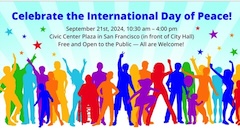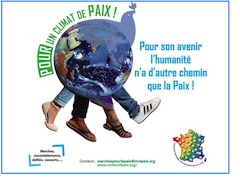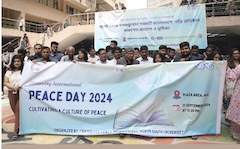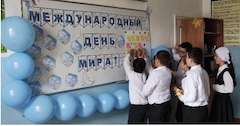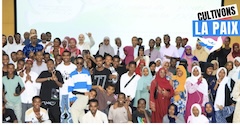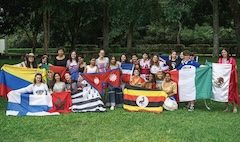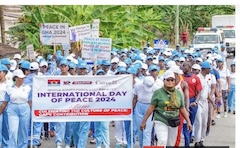Expressed in Russian or Ukrainian, English or French, Japanese or Hindi, Arab or Spanish, Italian or Portuguese, the message is the same. The people of the world want peace! For the International day of Peace, more than 800 events in these languages may be found on the Internet, and we have published excerpts from them in the pages of CPNN last week. This year the official United Nations slogan is “Cultivating a Culture of Peace.”
The greatest number, 391 or almost half of the actions, càme from Western Europe. Expressed mostly in French and organized for the most part by the Mouvement de la Paix and militant trade unions, there were rallies bearing the rainbow flag of peace in over half of the more than 100 departments of France. Expressed mostly in Italian, there were events for the International Day of Peace in 44 cities and towns of Italy, led by the annual peace march of Assisi that drew marchers from many other cities. In Belgium, 189 cities and towns hung the rainbow banner of peace from their public buildings. In Portugal, dozens of towns and schools hung white cloth in their windows to express their desire for peace. Spain and the United Kingdom also saw many actions. “If you want peace, prepare peace” was a frequent slogan.
In North America, there were 151 actions for the day of peace in 44 of the 50 states of the United States, with the most in California and Florida. City-wide celebrations took place in cities such as San Francisco, Chicago and Boston. In San Francisco the slogan was “You are a pathway to peace. Everyone is a pathway to peace.” School, universities and churches organized a great variety of actions to celebrate the day. While in Canada, there were events in 6 of the 10 provinces as well as an official declaration by the Prime Minister: “This week, as the UN General Assembly begins in New York City, let’s recommit ourselves to working together to build a better, safer, and more peaceful world.”
Despite the devastation of the war and the fact that it is illegal to mention it in Russia, there were 32 celebrations published on the Internet from Ukraine and 30 from Russia. While calling for peace, many of the actions emphasized support for their side of the war. In Moscow, where people have been sent to prison because they called for peace, many brought flowers and paper doves to put on the sculpture named “We demand peace!”. In the Ukraine, there were celebrations calling for peace that took place in air raid shelters during bombardments. As usual where it was possible, in many libraries and schools, children made paper doves and released colored balloons to mark the day. Perhaps most ironic was the article from Moldova where a school celebration was criticized for flying the rainbow flag of peace, because the rainbow flag can also be interpreted as support for homosexual rights.
There were 23 actions in 13 Arab and Middle Eastern countries, mostly reported in Arabic. Some of them emphasized the role of women for peace. The Syrian Women’s Council in Manbij Canton organized a dialogue seminar on the International Day of Peace, stressing the necessity of resolving the Syrian crisis and establishing peace there. In Aden, Yemen, An event was held with the participation of elite female cadres and members of the Women’s Solidarity Network, with discussions about the status of women and the importance of reflecting their priorities and needs in the Beijing Report.
In Asia and Pacific, there were 64 events in 14 countries, with the most published in Japanese and Hindi. In Japan, The organization “Wa Project TAISHI,” mobilized calligraphy clubs and 27 calligraphers from 49 schools nationwide to dedicate calliography messages of peace to Gokoku shrines around the country. At a conference in Mumbai sponsored by the International Institute for Peace through Tourism, Ajay Prakash its new president, spoke eloquently on the power of Tourism to connect people across all boundaries of race, religion or nationality. In Nanjing, China, Chinese and foreign young people from 11 countries gathered to sing songs of peace and sow purple gold grass seeds which symbolize peace. One student said: “It is very meaningful to sow these seeds with my own hands. I hope that when the Purple Grass flowers bloom in March next year, people can see these flowers and remember the history behind them.”
In Latin America and the Caribbean there were 59 actions in 19 countries, led by Argentina with 17 and Mexico with 16. In Nueva Leon, Mexico, The Nobel Peace Prize Laureates World Summit was timed to coincide with the International Day of Peace. 18 Nobel Peace Prize winners participated, as well as 1,200 young people from more than 70 universities across the country. vIn Mexico, the actions were especially emotions in the face of the violence that is tearing the country apart. The demonstration in Culiacán called on people not to normalize or accept the conditions of violence and fear that persist in the city, which have left more than 60 murders and more than 70 forced disappearances. In Colombia, events were dedicated to reconciliation and consolidation of the Peace Accords.
In Sub-Saharan Africa, there were 43 actions in 26 countries for the International Day of Peace. The official remarks of the African Union recognized the important role of the Biennale of Luanda. , the Pan-African Forum for the Culture of Peace. This year there was considerable participation by the military in African countries. In Nigeria, it was organized by the Security and Civil Defence Corps. In Ghana, it was organized by the Ghana Armed Forces at Airforce Base Takoradi. In Niger, it was organized by the by the High Authority for the Consolidation of Peace. In Gabon, the celebration took place in the stadium of the national gendarmerie. In Burkhina Faso the Ministry of Justice called for a return to endogenous values for the construction of peace and tolerance.
Among the many virtual events for the International Day of Peace, we may mention the following:
Dancing for Peace
Medicine for the Culture of War
Conference: Resisting the USA’s Military Empire
Songs for World Peace
Unite4Peace Worldwide Broadcast
The total number of actions this year was 834. This is greater than last year’s 942 if one adds the 153 new Montessori schools counted last year but no longer available on the Internet this year.
|
GLOBAL |
UNITED STATES AND CANADA |
ASIA AND PACIFIC |
|
EX-SOVIET COUNTRIES |
ARAB STATES AND MIDDLE EAST |
LATIN AMERICA AND CARIBBEAN |
AFRICA |

